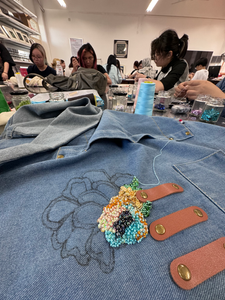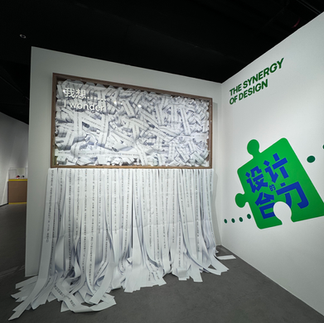Xiamen Exchange: Bridging Cultures Through Art & Design
- Jentok

- Mar 28
- 6 min read
Updated: Apr 13
NAFA International Learning Journey | 10–28 June 2024
As part of the NAFA Diploma in Art Teaching programme, I had the enriching opportunity to participate in a 3-week overseas immersion at Xiamen University of Technology (XMUT), China. This cultural and academic exchange deepened my understanding of contemporary and traditional Chinese visual arts and broadened my perspectives on global art education.
🌏 Cultural Immersion & Artistic Exploration
During this immersive learning experience, we explored a diverse curriculum that included:
Traditional Chinese Ink Painting
As we painted, the session took on deeper meaning with a timely discussion on the Dragon Boat Festival (端午节). The instructor shared insights into the cultural and historical symbolism of the festival, which commemorates the ancient poet Qu Yuan (屈原) — a symbol of loyalty, wisdom, and integrity. His selfless act and the collective mourning by his people gave rise to rituals like dragon boat racing and eating rice dumplings (粽子), traditions rooted in remembrance and unity.
Through this session, we reflected on how Chinese ink painting is not just about technique, but also about embodying cultural values and ancestral stories. The practice of slowing down to paint with purpose became a way to honor heritage — a moment to connect with tradition through artistic expression.
Chinese Architecture & Design

This photo shows a beautiful example of traditional Chinese architecture we explored during our cultural immersion in Xiamen. The building features curved tiled roofs, wooden beams, and detailed carvings, all designed with a sense of balance and harmony.
The wide overhanging eaves protect the space from sun and rain, while the open layout encourages gathering and connection. Made with natural materials like wood and clay, the structure blends beautifully with its surroundings — reflecting a deep respect for nature, community, and tradition.
This experience helped me see how architecture can tell a cultural story, something I’m inspired to bring into my own creative work.
Our exploration into traditional Chinese architecture introduced us to the philosophy of balance, harmony, and nature-inspired spatial design. We studied Fujian-style homes, courtyards, and iconic structures that reflect Confucian ideals and ancestral reverence. This experience deepened our appreciation for the aesthetic and functional interplay between architecture, cultural symbolism, and environmental adaptation. It also inspired reflections on how space and structure can be designed with meaning — an idea I hope to incorporate into future installation works or workshop settings that prioritize calm, flow, and cultural storytelling.
Contemporary Bead Embroidery & Batik Art
We engaged in hands-on sessions exploring contemporary bead embroidery and batik art, both of which hold rich cultural and artistic significance in Southeast Asia and China. The bead embroidery workshop allowed us to understand how traditional handcraft is being preserved and reimagined in contemporary fashion and art. Meanwhile, the batik session introduced us to wax-resist dyeing techniques, where we created patterns that fused modern motifs with heritage textures. These practices reminded us of the power of textiles as both narrative and decorative forms, blending craft with personal expression — much like how I approach floral design and surface embellishment in my own practice.
Visit to Red Dot Design Museum: Inspiration Through Innovation
As part of our cultural learning journey in Xiamen, we visited the Red Dot Design Museum, a space filled with award-winning products and innovations from around the world. The exhibits showcased how design thinking can solve real-world problems, blending creativity with function in everyday objects.
I was particularly inspired by how each design tells a story — whether through sustainable materials, user-centered function, or cultural symbolism. The visit reminded me that good design is not just about how something looks, but how it feels, functions, and serves a purpose.
This experience sparked new ideas for how I can apply thoughtful, human-centered design into my own floral art, workshop layouts, and community-based projects.
🏛️ Experiential Highlights
🌴 Gulangyu Island: Where Heritage Meets the Sea
Our visit to Gulangyu Island (鼓浪屿) was like stepping into a beautifully preserved chapter of history. Just a short ferry ride from Xiamen, the island is renowned for its blend of European colonial architecture, local Minnan culture, and scenic coastal views.
Designated as a UNESCO World Cultural Heritage Site, Gulangyu was once an international settlement, home to foreign consulates, churches, and mansions — many of which remain today as elegant remnants of East-meets-West influences. Walking through its car-free, winding streets, we admired the Baroque and neoclassical façades, red-bricked villas, and leafy courtyards, each telling a story of cultural exchange and resilience.
Beyond its architectural charm, the island's natural beauty — from its ocean breeze to its rocky shorelines and panoramic views — created a tranquil, almost poetic atmosphere. Whether standing by the coastline or exploring old music halls and tea houses, every corner felt like an invitation to slow down, reflect, and be inspired.
For me, Gulangyu was more than just a sightseeing stop; it was a reminder of how art, history, and nature can coexist in harmony, and how places carry memory through their design, their people, and their stories.
🏡 Tianluokeng Tulou Cluster: A Glimpse into Communal Heritage
One of Fujian’s most iconic UNESCO World Heritage sites. Surrounded by lush mountains, the Tulou structures — known for their round and square earth buildings — stand as living testaments to Hakka culture, communal living, and sustainable design.
As we explored the site, we were struck by the harmony between architecture and nature, and how these fortified homes were built not only for protection but also for generations to live together in unity. The peaceful atmosphere and intricate layout offered us a rare perspective on rural Chinese traditions and community values that still thrive today.
🖌️ Field Visits: From Contemporary Design to Traditional Craftsmanship
During our time in Xiamen, we had the unique opportunity to visit two very different yet equally inspiring creative spaces — Shangpin Design Company and 锡雕侠侣非遗手作 (Xi Diao Xia Lü Intangible Heritage Handcraft Studio).
🧠 Shangpin Design Company
At Shangpin, we were introduced to the modern world of product and lifestyle design, where innovation meets aesthetics. The studio showcased how design thinking is applied to everyday objects — blending functionality, market awareness, and visual appeal. We gained insights into their design development process, from concept ideation and prototyping to final presentation. It was inspiring to see how the team emphasized material exploration, branding, and user-centered design.
🛠️ 锡雕侠侣非遗手作 – Traditional Pewter Carving Studio
In contrast, our visit to 锡雕侠侣 offered a deep dive into Chinese traditional pewter carving, a form of intangible cultural heritage. The studio, run by passionate artisans, demonstrated how centuries-old techniques are preserved through meticulous handwork and storytelling. Watching the artists at work — engraving, shaping, and detailing pewter into symbolic designs — was a powerful reminder of the value of craftsmanship, cultural continuity, and patience.
These visits bridged the worlds of contemporary design and traditional artistry, encouraging us to consider how history, technique, and innovation can co-exist and enrich each other. Both experiences left a lasting impression on how I think about material use, narrative, and purpose in my own creative practice.
🎨 Key Takeaways
Cross-Cultural Learning: Understanding the values embedded in traditional Chinese design philosophies and applying them to contemporary art education.
Studio Practice: Strengthening my technical skills and conceptual approaches through daily workshops and critiques.
Community Engagement: Sharing perspectives with fellow artists and educators from both NAFA and XMUT.
🧠 Reflection

This photo captures Rose, our late friend and fellow participant, during a quiet moment in Xiamen. Behind her is a sign that reads:
“好慷赞美女性奋斗精神”Praises the spirit of women's perseverance and determination.
Although the signboard and setting were part of a public display, the message unintentionally frames this image in a poignant and symbolic way. Rose’s presence in front of this tribute to women’s strength now feels like a silent homage — honoring her resilience, grace, and the spirit she brought to those around her.
This photo, once casual, now carries emotional weight. It reminds us how small moments can become lasting symbols of memory, meaning, and quiet strength.
In summary, this journey reminded me of the power of cultural exchange in enriching art education. I return inspired by the elegance of traditional techniques and the potential of integrating cross-disciplinary, cross-cultural methods into my own wellness workshops that blend heritage, nature, and creative expression.






































Comments